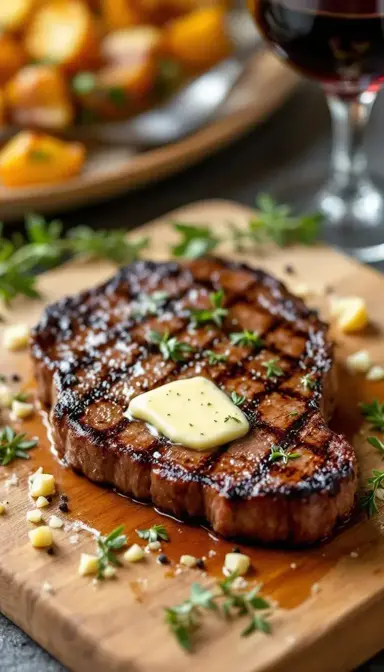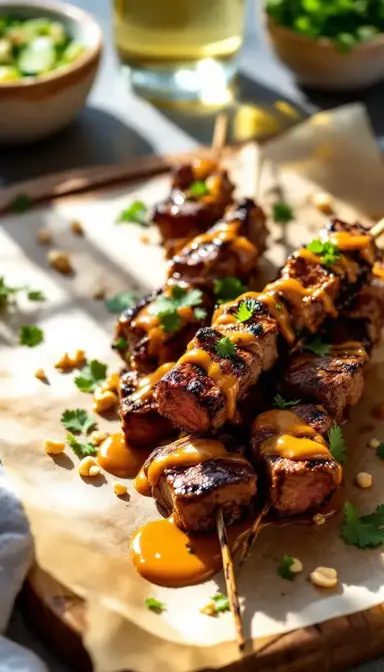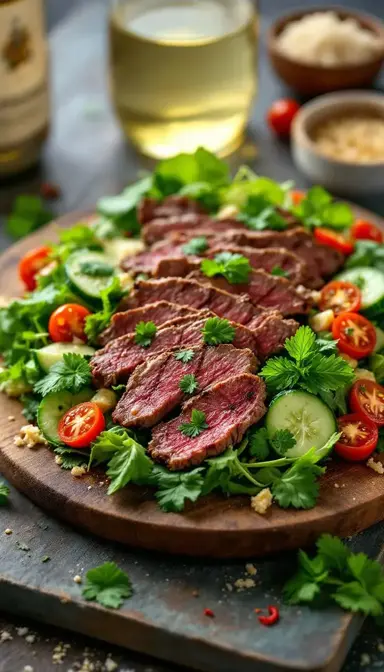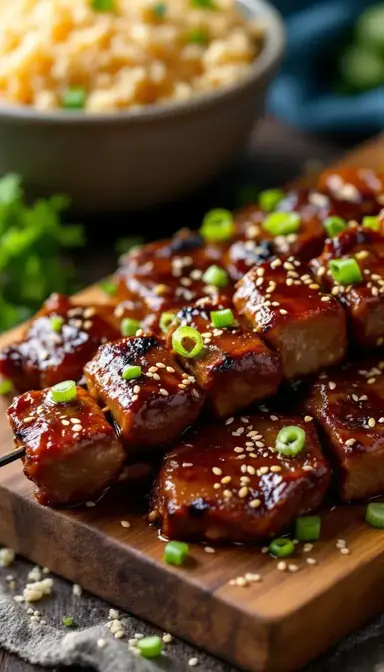There’s something almost magical about a well-cooked Bavette steak. It’s the kind of cut that makes you feel like you’ve unlocked a secret—rich, beefy, and with just enough chew to remind you it’s got character. I still remember the first time I seared one properly, the way the garlic butter pooled into the crevices of that caramelized crust. It was a Tuesday night, but it tasted like a celebration.
This isn’t just another steak recipe. It’s a lesson in restraint and technique, where high heat and good timing turn an underrated cut into something extraordinary. Bavette (or “flap meat,” as some butchers call it) is like flank steak’s French cousin—slightly more marbled, a tad more forgiving. And when you pair it with garlic-thyme butter? Well, let’s just say your cast-iron skillet is about to become your best friend.
Why This Recipe Works
- The Sear Matters: That sizzle when the steak hits the pan isn’t just theater—it’s the Maillard reaction working its flavor alchemy. High heat creates a crust that locks in juices and develops deep, savory notes.
- Butter Basting is Non-Negotiable: Spooning melted garlic butter over the steak isn’t just for show; it’s like giving the meat a luxurious bath in flavor. The fat carries the aromatics into every bite.
- Resting is Respect: Skipping the rest is like opening a present early—you’ll regret it when all the juices escape onto the cutting board. Resting allows the fibers to relax and reabsorb moisture.
Essential Ingredients & Tools
Ingredients for the Steak
- 1.5 lbs Bavette steak: Look for even thickness and a deep red color. If it’s vacuum-sealed, pat it extra dry—that moisture will steam instead of sear. (Substitute: flank steak)
- 1 tbsp kosher salt: The flakes cling better than table salt, and they’re gentler on the palate.
- 1 tsp freshly cracked pepper: Pre-ground is fine in a pinch, but the fragrance of freshly cracked is worth the effort.
- 2 tbsp olive oil: High smoke point for searing. (Substitute: avocado oil)
Ingredients for the Garlic Butter
- 4 tbsp unsalted butter: Because you’re the boss of seasoning here. (Substitute: salted butter, but reduce added salt)
- 4 garlic cloves, minced: Smash them with the side of your knife first—it releases their oils and makes mincing easier.
- 1 tbsp fresh thyme leaves: Those little leaves are powerhouses. Strip them by pinching the stem and sliding your fingers down. (Substitute: rosemary or parsley)
Tools You’ll Need
- Cast-iron skillet: If you don’t have one, a heavy stainless steel pan works too. It’s the difference between a good crust and a great one.
- Tongs: No forks allowed—piercing the steak is like poking holes in a water balloon.
- Instant-read thermometer: Takes the guesswork out. Aim for 130°F for medium-rare (it’ll climb to 135°F as it rests).
How to Make Pan-Seared Bavette with Garlic
- Dry the Steak Like It Owes You Money
Moisture is the enemy of crust. Pat every inch with paper towels until it feels like suede. Season aggressively—1 tbsp kosher salt and 1 tsp freshly cracked pepper should look like a light snowfall. Let it sit uncovered at room temp for 15 minutes. This isn’t just about taking the chill off; it’s about ensuring even cooking.
- Heat the Pan Like You Mean It
Medium-high heat. Add 2 tbsp olive oil just before it smokes. When it shimmers like a mirage in the desert, it’s go-time.
- Sear with Confidence
Lay the 1.5 lbs Bavette steak down away from you (no oil splatters on your shirt). Don’t touch it for 4 minutes—that crust needs uninterrupted time to form. Flip once. If you’re feeling fancy, use tongs to sear the edges like you’re browning the sides of a marshmallow.
- Butter Ballet
Lower the heat. Add 4 tbsp unsalted butter, 4 minced garlic cloves, and 1 tbsp fresh thyme leaves. The butter will foam—that’s your cue to tilt the pan and spoon it over the steak continuously. The garlic should sizzle but not brown too much. If it starts to, pull the pan off the heat for a few seconds.
- The Patient Wait
Transfer to a cutting board. Tent loosely with foil—not tight, or you’ll steam the crust. Let it rest for 5-10 minutes. This is when the magic happens inside; the juices redistribute like guests finding their seats at a dinner party.
- Slice with Purpose
Find the grain (those long muscle fibers running parallel). Cut across them, not with them. Think of it like cutting a deck of cards—short strokes for tender bites.
Chef’s Wisdom
- Dry-Brine Overnight: Salt the steak, leave it uncovered on a rack in the fridge overnight. The salt works its way deep, seasoning from within and tenderizing the meat. Game-changer.
- Basting Hack: Keep the garlic moving in the butter. Burnt garlic is bitter, and we’re not here for bitterness.
The Story Behind the Sauce
This cut is the blue-collar hero of the steak world. It’s got flavor for days, and when treated right, it’s as tender as cuts twice its price. The key? That intramuscular fat—it melts as it cooks, basting the steak from the inside out.
Storage & Freshness Guide
- Leftovers: Wrap cooled steak in foil, then stash it in the fridge. Next day, slice it thin for sandwiches or dice it for a killer steak salad. Reheat gently in a skillet with a splash of broth to keep it juicy.
- Raw Storage: Keep uncooked Bavette in the fridge for up to 3 days or freeze for 2-3 months. Thaw overnight in the fridge—never on the counter.
Perfect Pairings
Complementary Dishes
- Crispy Roasted Potatoes: The crunchy exterior and fluffy interior contrast the steak’s tenderness, while the neutral starch soaks up the garlic butter.
- Bitter Greens Salad: Arugula or radicchio with a lemon vinaigrette cuts through the richness, cleansing the palate.
Drinks
- Syrah: This bold red wine’s peppery notes and dark fruit flavors mirror the steak’s intensity.
- Amber Ale: The malt sweetness and carbonation balance the savory, buttery notes.
Something Sweet
- Dark Chocolate Mousse: The bitterness of dark chocolate echoes the steak’s char, creating a sophisticated finish.
- Poached Pears: Lightly spiced pears offer a refreshing, slightly sweet contrast.

Pan-Seared Bavette with Garlic: A Butcher’s Cut Worth Mastering
Learn how to make Pan-Seared Bavette with Garlic—a juicy, flavorful steak with a garlic-thyme butter finish. Perfect for weeknights or date nights! Try it tonight.
Ingredients
For the Steak
-
1.5 lbs Bavette steak
-
1 tbsp kosher salt
-
1 tsp freshly cracked black pepper
-
2 tbsp olive oil
For the Garlic Butter
-
4 tbsp unsalted butter
-
4 cloves garlic (minced)
-
1 tbsp fresh thyme leaves
Instructions
-
Pat the 1.5 lbs Bavette steak dry with paper towels and season liberally with 1 tbsp kosher salt and 1 tsp freshly cracked black pepper. Let sit at room temperature for 15 minutes.01
-
Heat 2 tbsp olive oil in a cast-iron skillet over medium-high heat until shimmering.02
-
Sear the steak undisturbed for 4-5 minutes per side, flipping once.03
-
Reduce heat to medium, add 4 tbsp unsalted butter, 4 minced garlic cloves, and 1 tbsp fresh thyme leaves. Baste the steak continuously for 1-2 minutes.04
-
Transfer to a cutting board, tent with foil, and rest for 5-10 minutes.05
-
Slice against the grain and serve with pan juices.06



